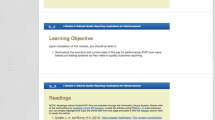Abstract
AT LEAST THREE PURPOSES FOR ONLINE TEACHING can be conceptualized: quick dissemination of course information, Web-enabled supplements, and Web-engaged activity. Simply disseminating course information online is necessary for distance courses and promotes efficiency for face-to-face courses, but arguably does not improve learning for either. Web-enabled supplements, however, take advantage of the multimedia nature of the Web, allowing students to research course-related materials previously unavailable or only available in dispersed locations. To promote higher-order thinking, Web-engaged activities can be designed that capitalize on student information processing tools.
A major concern of online course management systems is that they emphasize faculty dissemination tools over student processing tools, even though the latter are more likely to promote student interaction and engagement (e.g., debating, sharing data, developing common products, synthesizing information, exploring cases). Online course management systems should be evaluated on the basis of their ability to support planned learning goals and teaching strategies. Currently, many high-level goals and strategies are supported only by individual online tools. Faculty who rely upon integrated course management systems may be unable to involve their students in such activities as community building, research into ill-defined problems, and knowledge construction. If faculty find online course management systems only support information delivery and low-level knowledge comprehension goals, they should seek alternative tools and development options to engender high-level student analysis, synthesis, and evaluation activity.
Similar content being viewed by others
References
Applied History Research Group. (2000).Multimedia history tutorials [Online] Available: http://www.acs.ucalgary.ca/HIST/tutor/
Ayers, E.L. (1999).The pasts and futures of digital history. [Online] Available: http://www.vcdh.virginia.edu/PastsFutures.html
Ayers, E.L., & Thomas, W.G. (1998).The Valley of the Shadow. [Online] Available: http://jefferson.village.virginia.edu/vshadow2/choosepart.html
Beckman Institute for Advanced Science and Technology. (2000).VisIT: Visualization of information tool. [Online] Available: http://lrs.ed.uiuc.edu/students/kauwell/VisIT/
Berkman Center for Internet & Society. (2000).Annotation engine. [Online] Available: http://cyber.law.harvard.edu/projects/annotate.html
Blackboard, Inc. (2001).CourseInfo. [On-line]. [Online] Available: http://www.blackboard.com/
Bloom, B.S., Englehart, M.D., Furst, E.J., Hill, W.H., & Krathwohl, D.R. (1956).Taxonomy of Educational Objectives, Handbook 1: Cognitive Domain. New York: David McKay.
Chang, B.W. (1998).In-place editing of Web pages: Sparrow community-shared documents. [Online] Available: http://www.parc.xerox.com/istl/projects/sparrow/doc/www7/
Clements, D.H., & Nastasi, B.K. (1992). The role of social interaction in the development of higher-order thinking in Logo environments. In E.D. Corte, M.C. Linn, H. Mandl, & L. Verschaffel (Eds.),Computer-based learning environments and problem solving (pp. 229–248). Berlin: Springer-Verlag.
Gilliver, R.S., Randall, B.J., & Pok, Y.M. (1999).The orbicular model: Cognitive learning in cyberspace. Educational Technology Review, 12, 18–22.
Guzdial, M. (in press). Collaborative Websites to support an open authoring community on the Web.Journal of the Learning Sciences. [Online] Available: http://guzdial.cc.gatech.edu/papers/CoWeb/
Hannafin, M.J., Land, S., & Oliver, K. (1999). Open learning environments: Foundations, methods, and models. In C. Reigeluth (Ed.),Instructional-design theories and models: Volume II (pp. 115–140). Mahwah, NJ: Lawrence Erlbaum Associates, Publishers.
Institute for Human and Machine Cognition. (2000).Concept map software: A knowledge construction toolkit. [Online] Available: http://wwwcmap.coginst.uwf.edu/
Jonassen, D.H., Myers, J.M., & McKillop, A.M. (1996). From constructivism to constructionism: Learning with hypermedia/multimedia rather than from it. In B.G. Wilson (Ed.),Constructivist learning environments (pp. 93–106). Englewood Cliffs, NJ: Educational Technology Publications.
Learning in Motion. (2001).Knowledge Forum. [Online] Available: http://www.learn.motion.com/lim/kf/KF1.html
Lehrer, R. (1993). Authors of knowledge: Patterns of hypermedia design. In S.P. Lajoie & S.J. Derry (Eds.),Computers as cognitive tools (pp. 197–227). Hillsdale, NJ: Lawrence-Erlbaum Associates, Publishers.
McHenry, B.A. (2000).New features for learning management systems [Online] Available: http://www.imsproject.org/feature/lms/lms.html
Means, B., & Coleman, E. (2000). Technology supports for student participation in science investigations. In M.J. Jacobson, & R.B. Kozma (Eds.),Innovations in science and mathematics education: Advanced designs for technologies of learning (pp. 287–319). Mahwah, NJ: Lawrence Erlbaum Associates, Publishers.
Merlot. (2001).A national teaching and learning network for faculty. [Online] Available: http://www.merlot.org/Home.po
Morphew, V.N. (2000). Web-based learning and instruction: A constructivist approach. In L. Lau (Ed.),Distance learning technologies: Issues, trends, and opportunities (pp. 1–15). Hershey, PA: Idea Group Publishing.
Oliver, K. (2000).Quick guide: Web-based instruction. [Online] Available: http://www.edtech.vt.edu/edtech/id/wbi/index.html
Salomon, G. (2000, June).It’s not just the tool, but the educational rationale that counts. Keynote address presented at Ed-Media 2000, Montreal, Quebec, Canada [Online] Available: http://construct.haifa.ac.il/~gsalomon/edMedia2000.html
Slotta, J.D., & Linn, M.C. (2000). The Knowledge Integration Environment: Helping students use the Internet effectively. In M.J. Jacobson, & R.J. Kozma (Eds.),Innovations in science and mathematics education: Advanced designs for technologies of learning (pp. 193–226). Mahwah, NJ: Lawrence Erlbaum Associates, Publishers.
Society for Pediatric Pathology Online. (2000).Pediatric pathology case studies. [Online] Available: http://path.upmc.edu/spp/casedx.htm
University of Michigan. (2000).Center for highly interactive computing in education. [Online] Available: http://hi-ce.org/
Vosniadou, S. (1994). Capturing and modeling the process of conceptual change.Learning and Instruction, 4, 45–69.
WebCT. (2001).WebCT. [Online] Available: http://www.Webct.com/
Weborganic Systems. (2001).Weborganic systems. [Online] Available. http://www.weborganic.com/
Xerox Palo Alto Research Center. (2000).Sparrow: Community shared Web pages. [Online] Available: http://www.parc.xerox.com/istl/projects/sparrow/
Author information
Authors and Affiliations
Additional information
Kevin Oliver is an Instructional Designer and Evaluator with the Educational Technologies group at Virginia Tech and an Adjunct Assistant Professor with the Department of Teaching & Learning. He helps faculty develop technology-based materials for on- and off-campus courses, conducts evaluations of university technology innovations, and provides teaching support for the award-winning Faculty Development Institute.
Dr. Oliver earned his Ph.D. in Instructional Technology from the University of Georgia and his M.Ed. in Educational Media and Instructional Design from the University of North Carolina at Chapel Hill. He is actively involved in the Association for Educational Communications and Technology (AECT) and the Association for the Advancement of Computing in Education (AACE). He has presented over forty workshops and presentations to local, regional, national, and international audiences.
Dr. Oliver major development interests include online resources and interactive tools to support faculty development and to foster the appropriate application of technology by faculty. His major research interests include the design and development of cognitive tools to promote critical thinking and mental model development in students.
Rights and permissions
About this article
Cite this article
Oliver, K. Recommendations for student tools in online course management systems. J. Comput. High. Educ. 13, 47–70 (2001). https://doi.org/10.1007/BF02940944
Issue Date:
DOI: https://doi.org/10.1007/BF02940944




